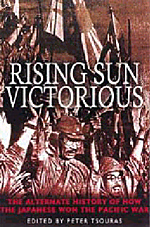 Rising Sun Victorious: The Alternate History of How the Japanese Won the Pacific War
Rising Sun Victorious: The Alternate History of How the Japanese Won the Pacific War
Edited by Peter G. Tsouras, Greenhill Books/Stackpole Books, 2001, 256 pp, $34.95.
Rising Sun Victorious is a collection of ten essays by respected historians and authors who examine alternative outcomes of key decisions or events during WW II in the Pacific. The authors provide a wealth of grist for the “what if ” mill, which makes this an attractive book for the historian and scenario designer, particularly at a strategic level. The ten essays are:
- Hokushin: The Second Russo-Japanese War by Peter Tsouras examines an alternative without the US entering the war. Instead, the Japanese attack Russia, pushing aside units plagued by officer purges and depleted by troop transfers to fight Hitler.
- Be Careful What You Wish For: The War Plan Orange Disaster by Wade Dudley has the US Pacific Fleet executing War Plan Orange without the attack on Pearl Harbor, but being defeated in the Philippines by skillful maneuvering and deception by Admiral Yamamoto.
- Pearl Harbor: Irredeemable Defeat by Frank Shirer covers the missed opportunity of the Third Wave attack on Pearl Harbor, with the loss of Enterprise and several cruisers, disrupting future operations.
- Coral and Purple: The Lost Advantage by James Arnold posits the Japanese realization that the US is reading their codes, with a changeover occurring between the battles of Coral Sea and Midway, canceling out the significant signals intelligence advantage and resulting in the US loss at the battle of Midway.
- Nagumo’s Luck: The Battles of Midway and California by Forrest Lindsey posits a ‘safe decision’ by Commander Wade McCluskey who heads towards Midway to refuel instead of following a hunch that ended in the loss of the Japanese carriers at Midway. The results of the decision start a chain of events leading to the destruction of the US carriers, and the war coming to American soil.
- Samurai Down Under: The Japanese Invasion of Australia by John Gill details the invasion of the east coast of Australia following the Allied defeat at the Battle of Coral Sea.
- The Japanese Raj: The Conquest of India by David Isby takes a view on a continued expansion of the Japanese conquest beyond Burma in 1942. The internal political situation in India and the lack of the Japanese to effectively assimilate a conquered people play a key role.
- Guadalcanal: The Broken Shoestring by John Burtt presents a new view of the struggle to control the vital airfields of the lower Solomons, with Admiral Ghormley remaining in command instead of being replaced by Halsey. Combining timid leadership with a few more critical losses, the US is forced to withdraw.
- There Are Such Things As Miracles: Halsey and Kurita at Leyte Gulf by Christopher Anderson presents the classic ‘what if ’ of the Leyte Gulf battles, when the northern force under Admiral Kurita punches through the escort carriers and destroys the assembled transports in Leyte Gulf.
- Victory Rides the Divine Wind: The Kamikaze and the Invasion of Kyushu by D. M. Giangreco depicts the outcome of a US landing on Kyushu from the perspective of a Naval War College seminar by Admiral Richmond ‘Kelly’ Turner in 1946, outlining the effects of poor intelligence assessments, radar performance close to the coast and mountains, heavy losses and tactical use of nuclear weapons to bring a negotiated end to the war.
The essays are lavishly footnoted to provide further research pointers. The essays are wholly believable, and make compelling reading. While Japan ends up losing the war in most cases, it still comes out ahead by extending the war or retaining more of its historical gains.
BT
Back to The Naval Sitrep #21 Table of Contents
Back to Naval Sitrep List of Issues
Back to MagWeb Master Magazine List
© Copyright 2001 by Larry Bond and Clash of Arms.
This article appears in MagWeb (Magazine Web) on the Internet World Wide Web.
Other military history and related articles are available at http://www.magweb.com